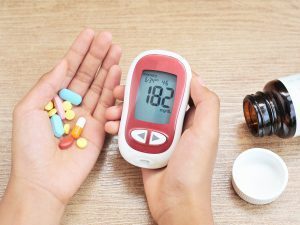- Home
- Editorial
- News
- Practice Guidelines
- Anesthesiology Guidelines
- Cancer Guidelines
- Cardiac Sciences Guidelines
- Critical Care Guidelines
- Dentistry Guidelines
- Dermatology Guidelines
- Diabetes and Endo Guidelines
- Diagnostics Guidelines
- ENT Guidelines
- Featured Practice Guidelines
- Gastroenterology Guidelines
- Geriatrics Guidelines
- Medicine Guidelines
- Nephrology Guidelines
- Neurosciences Guidelines
- Obs and Gynae Guidelines
- Ophthalmology Guidelines
- Orthopaedics Guidelines
- Paediatrics Guidelines
- Psychiatry Guidelines
- Pulmonology Guidelines
- Radiology Guidelines
- Surgery Guidelines
- Urology Guidelines
Type 1 diabetes: HbA1c levels above 6.9% associated with complications, finds BMJ study

Sweden: Researchers from Sweden have identified a window of HbA1c levels that can control complications in people with type 1 diabetes.
According to the study, maintaining HbA1c levels between 48 and 52 mmol/mol (6.5% and 6.9%) reduce the risk of diabetes complications in people with type 1 diabetes, according to a recent study.
The study, published in the BMJ journal, found that risk of nephropathy and retinopathy did not differ at HbA1c levels <6.5% but increased for severe hypoglycemia (low blood sugar) compared with HbA1c levels 6.5-6.9%.
The risk for severe complications mainly occurred at HbA1c levels >8.6%, but for milder complications was increased at HbA1c levels >7.0%.
According to Mayo Clinic, type 1 diabetes, once known as juvenile diabetes or insulin-dependent diabetes, is a chronic condition in which the pancreas produces little or no insulin. Insulin is a hormone needed to allow sugar (glucose) to enter cells to produce energy.
Multiple studies have confirmed that a higher HbA1c level is an independent risk factor for diabetes complications. But still, there exists no concrete evidence for the association between the two in type 1 diabetes patients.
Marcus Lind, University of Gothenburg, Gothenburg, Sweden, and colleagues evaluated if the lowest target level for glycated haemoglobin (HbA1c) of <6.5% is associated with a lower risk for retinopathy and nephropathy than less tight control in children and adults with type 1 diabetes.
For the purpose, the researchers used data from the Swedish Diabetes Registry which included over 10,000 adults and children with type 1 diabetes. The researchers grouped the participants into five categories depending on their HbA1c levels.
The lowest HbA1c category was for participants with HbA1c levels of below 48 mmol/mol (6.5%). The highest HbA1c category was for those with an HbA1c of greater than 71 mmol/mol (8.6%). The team reviewed risk of complications including retinopathy, nephropathy (kidney disease) and episodes of severe hypoglycemia.
Key findings of the study include:
- Retinopathy and nephropathy were more likely in people with an HbA1c of 53 mmol/mol (7%) and above.
- More severe forms of these complications, proliferative retinopathy and chronic kidney disease, were more likely in people with an HbA1c level above 71 mmol/mol (8.6%).
- People with an HbA1c of below 53 mmol/mol (6.5%) had an increased risk of experiencing severe hypoglycemia.
"We found no difference in risk of retinopathy and nephropathy at HbA1c levels <6.5% (<48 mmol/mol) but an increased risk of severe hypoglycaemia compared with levels of 6.5-6.9% (48-52 mmol/mol). Severe complications mainly occurred at HbA1c levels >8.6% (>70 mmol/mol), whereas the risk of milder complications increased at HbA1c levels >7.0% (>53 mmol/mol). In people with HbA1c levels <6.5% (<48 mmol/mol), clinicians should focus on avoidance of frequent hypoglycaemia and obtaining a good diabetes-related quality of life, or else increase the target level to 6.5-6.9% (48-52 mmol/mol)," wrote the authors.
"Other measures, including time in range, time in hypoglycaemia, and variation in glycaemia will be essential complementary measures to HbA1c in clinical practice and future studies," they concluded.
More Information: "HbA1c level as a risk factor for retinopathy and nephropathy in children and adults with type 1 diabetes: Swedish population-based cohort study" published in the BMJ journal.
DOI: https://doi.org/10.1136/bmj.l4894
Journal Information: British Medical Journal

Disclaimer: This site is primarily intended for healthcare professionals. Any content/information on this website does not replace the advice of medical and/or health professionals and should not be construed as medical/diagnostic advice/endorsement or prescription. Use of this site is subject to our terms of use, privacy policy, advertisement policy. © 2020 Minerva Medical Treatment Pvt Ltd